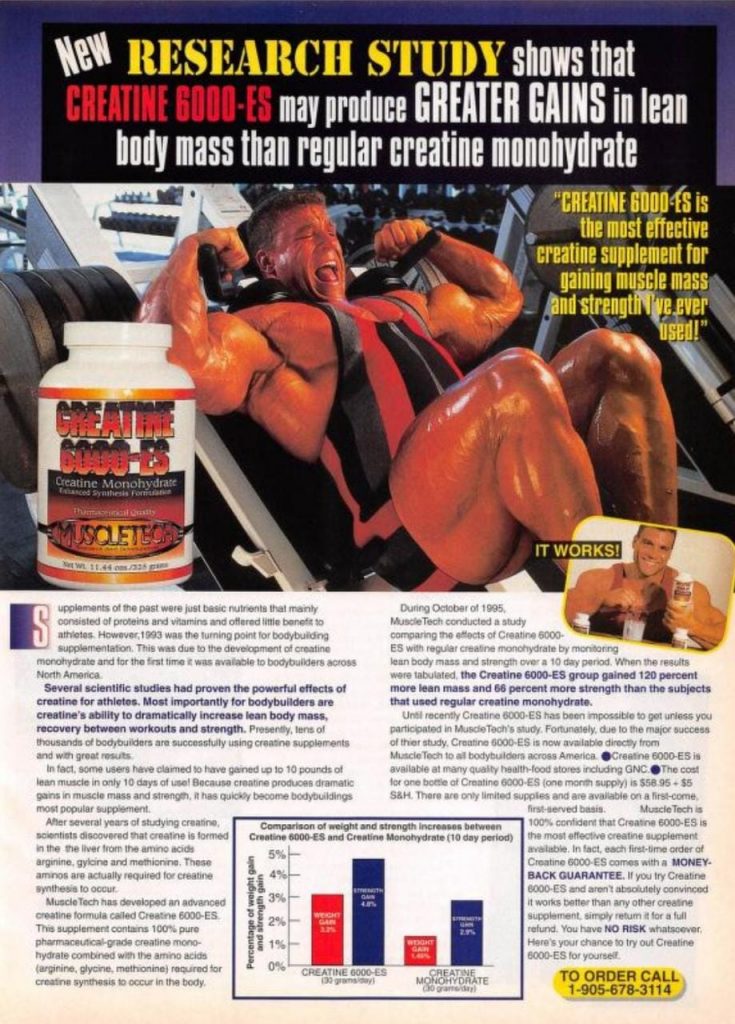Creatine is the best studied supplement in the history of dietary supplement research. The form of creatine that’s used in scientific studies and proven to work is Creatine Monohydrate (henceforth, Monohydrate). Yet, over the years, there has been countless “better” alternatives to good old Monohydrate. Some were found to be worse than Monohydrate, some were as good but came with a hefty price tag, leaving CM as the World’s #1 most cost-effective creatine supplement for more than 3 decades…
How and Why did the New Creatines come about?
Monohydrate has become an ingredient that many manufacturers are able to produce at a very good price. In the good old days when creatine was a new kid on the block (mid 90s), I remember that Creatine used to cost an arm and a leg. Today, Creatine costs a fraction of what it used to cost more than 25 years ago.
As prices went down, the industry quickly started getting creative and began devising formulations to justify a higher price. A very popular idea, pioneered by an American company in the late 90s, was to add Creatine to a whole bunch of carbs and a sprinkle of some other ingredients plus hefty dose of flavouring. A whole new category of “creatine transport” supplements was born. The added carbs were purported to enhance the absorption of creatine into muscles.
Then “Creatine Serum” had a short stint in the early to mid-2000s but rapidly faded into oblivion due to stability issues. The late 2000s to early 2010s saw “buffered Creatines” and “Creatine Ethyl Ester-CEE” hitting the shelves big time.
 Down memory lane: one of the earliest “pure monohydrate alternatives” was Muscletech’s Creatine 6000- ES (circa 1997) which is one of the 3 products they launched their brand with, the other being Acetabolan (Acetyl-L-Carnitine) and Hydroxycut. Creatine ES contained added Arginine, Glycine and Methionine which are precursors of Creatine synthesis.
Down memory lane: one of the earliest “pure monohydrate alternatives” was Muscletech’s Creatine 6000- ES (circa 1997) which is one of the 3 products they launched their brand with, the other being Acetabolan (Acetyl-L-Carnitine) and Hydroxycut. Creatine ES contained added Arginine, Glycine and Methionine which are precursors of Creatine synthesis. Issues that novel creatine formulations promise to address.
They all came with similar unique selling propositions:
- Dissolves more easily than monohydrate
- Absorbs better than monohydrate
- More potent than monohydrate, thus requiring a lower dose
- Doesn’t degrade in the stomach like monohydrate
- Doesn’t give “water retention” like monohydrate
- Doesn’t give “side effects” e.g cramping like monohydrate
- Champions use them, as alternative to Anadrol (LOL).
- Creatine HCL: Creatine Hydrochloride (HCL) emerged as a potential challenger to monohydrate, touting greater solubility and purportedly requiring smaller doses. However, a 2019 study debunked these claims, revealing that 3g of Creatine HCL was no more effective than its monohydrate counterpart. With limited scientific backing, the cost-effectiveness of Creatine HCL is questionable, making monohydrate the more prudent choice.
- Creatine Magnesium Chelate: Combining creatine with magnesium in Creatine Magnesium Chelate was anticipated to offer enhanced benefits. However, evidence suggests that this form does not outperform creatine monohydrate. As such, opting for creatine monohydrate remains a cost-effective and equally effective choice.
- Buffered Creatine: Market trends introduced buffered creatine, a blend of creatine monohydrate and sodium bicarbonate, with the promise of improved efficacy. However, research indicates that this patented concoction is not more effective than monohydrate, making its higher cost less justified. For budget-conscious consumers, creatine monohydrate continues to be the pragmatic choice.
- Creatine Blends: Some products tout the benefits of providing a blend of creatine forms, often incorporating 4-5 Creatine forms. However, given the lack of conclusive evidence supporting the superiority of alternative forms, the concept of a “creatine blend” appears more as a marketing gimmick than a scientific breakthrough. For consumers seeking reliable results and value for money, creatine monohydrate stands as the steadfast option.
Conclusion
While the market continues to introduce alternative forms of creatine, the question remains: will any creatine ever dethrone monohydrate? As of now, the answer appears to be uncertain. Creatine monohydrate’s long-standing reputation, coupled with its affordability and scientific backing, makes it a formidable opponent for any newcomer.
It’s essential for consumers to approach new forms of creatine with a critical eye, considering both scientific evidence and individual responses. Until more robust research emerges, creatine monohydrate will likely remain the go-to choice for those seeking a reliable and effective supplement to support their fitness and performance goals. While the potential for innovation in the world of sports nutrition is always exciting, creatine monohydrate’s throne seems secure for the time being.

To view my Professional Profile on LinkedIn: please click here
To see my latest product creations: www.bioteenhealth.com
To view my Scientific Publications on PubMed: please click here
To get in touch, please write to: info@supplementscientist.com
Follow supplementscientist.com on Facebook: please click here
Disclaimers
Medical: The information presented on this website is intended for adults 18 or over. Its aim is purely educational and does not constitute medical advice. Please consult a medical or health professional before you begin any program related to exercise, nutrition, or supplementation especially if you have a medical condition. If you consume any product mentioned on our site, you do so on your own free will, and you knowingly and voluntarily accept the risks.
Other: The views expressed in this blog article are solely mine and do not represent the opinions or positions of any company or institution with which I am associated. Any information or opinions provided are based on my personal experiences, research, and understanding. I strive to ensure accuracy and reliability of the information provided.







Leave a Reply